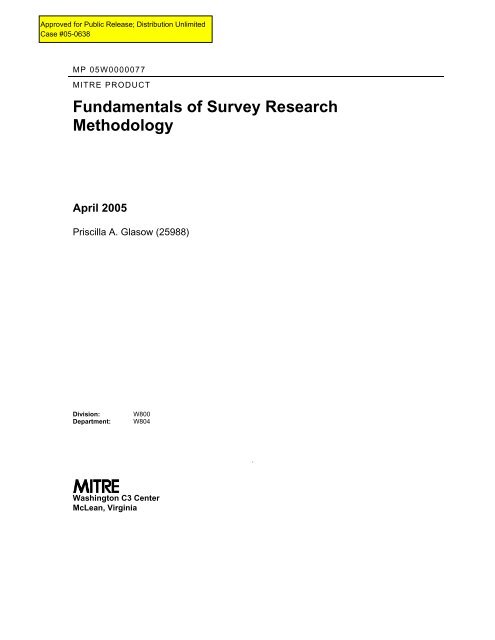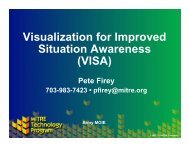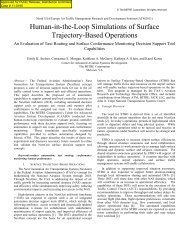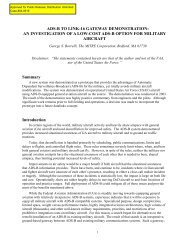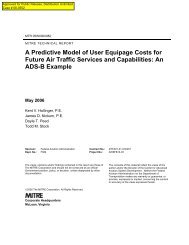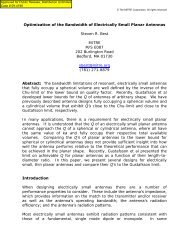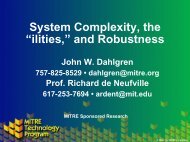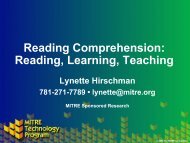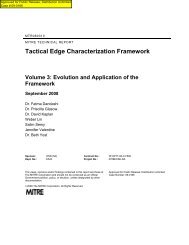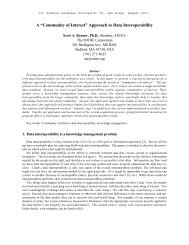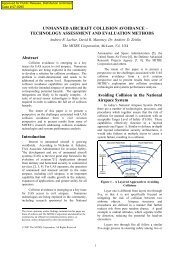Fundamentals of Survey Research Methodology - Mitre
Fundamentals of Survey Research Methodology - Mitre
Fundamentals of Survey Research Methodology - Mitre
You also want an ePaper? Increase the reach of your titles
YUMPU automatically turns print PDFs into web optimized ePapers that Google loves.
MP 05W0000077<br />
MITRE PRODUCT<br />
<strong>Fundamentals</strong> <strong>of</strong> <strong>Survey</strong> <strong>Research</strong><br />
<strong>Methodology</strong><br />
April 2005<br />
Priscilla A. Glasow (25988)<br />
Division:<br />
Department:<br />
W800<br />
W804<br />
Washington C3 Center<br />
McLean, Virginia<br />
.
MITRE Department<br />
Approval:<br />
Edward F. Gonzalez
Table <strong>of</strong> Contents<br />
Section Page<br />
1. What is <strong>Survey</strong> <strong>Research</strong>? 1-1<br />
1.1 <strong>Survey</strong> Strengths........................................................................................................... 1-1<br />
1.2 <strong>Survey</strong> Weaknesses....................................................................................................... 1-2<br />
1.3 Definition <strong>of</strong> Terms ...................................................................................................... 1-2<br />
2. The <strong>Survey</strong> Process 2-1<br />
2.1 <strong>Survey</strong> Design............................................................................................................... 2-1<br />
2.1.1 Sample Selection..................................................................................................... 2-1<br />
2.1.2 Sample Size............................................................................................................. 2-2<br />
2.1.2.1 Degree <strong>of</strong> Precision .......................................................................................... 2-2<br />
2.1.2.2 Statistical Power ............................................................................................... 2-2<br />
2.1.2.2.1 Effect Size as a Determinant <strong>of</strong> Power ....................................................... 2-3<br />
2.1.2.2.2 Sample Size as a Determinant <strong>of</strong> Power..................................................... 2-3<br />
2.1.2.3 Access to Subjects ............................................................................................ 2-3<br />
2.1.2.4 Stratification and Clustering............................................................................. 2-3<br />
2.1.2.5 Units <strong>of</strong> Analysis .............................................................................................. 2-3<br />
2.1.3 Choice <strong>of</strong> <strong>Survey</strong> Media ......................................................................................... 2-4<br />
2.1.3.1 Written <strong>Survey</strong>s................................................................................................ 2-4<br />
2.1.3.2 Verbal <strong>Survey</strong>s ................................................................................................. 2-4<br />
2.1.3.3 Mixed Mode <strong>Survey</strong>s ....................................................................................... 2-5<br />
2.2 <strong>Survey</strong> Instrument Development .................................................................................. 2-5<br />
2.2.1 Standards for Good <strong>Survey</strong> Questions.................................................................... 2-5<br />
2.2.1.1 Question Wording ............................................................................................ 2-5<br />
2.2.1.2 Feasible and Ethical.......................................................................................... 2-6<br />
2.2.1.3 Additional Considerations................................................................................ 2-6<br />
2.2.1.4 Biased Wording................................................................................................ 2-6<br />
2.2.1.5 Biased Context.................................................................................................. 2-6<br />
2.2.1.5.1 General Characteristics............................................................................... 2-6<br />
2.2.1.5.2 Cognitive Implications <strong>of</strong> Biased Context.................................................. 2-7<br />
2.2.1.5.3 Facets <strong>of</strong> Biased Context ............................................................................ 2-7<br />
2.2.2 Types <strong>of</strong> <strong>Survey</strong> Questions..................................................................................... 2-7<br />
2.2.2.1 Open-ended Questions...................................................................................... 2-7<br />
2.2.2.2 Closed-ended Questions ................................................................................... 2-7<br />
2.2.2.2.1 Questions that Describe and Evaluate People, Places and Events.............. 2-8<br />
2.2.2.2.2 Questions that Measure Responses to Ideas, Analyses or Proposals.......... 2-9<br />
2.2.2.2.3 Questions that Measure Knowledge ........................................................... 2-9<br />
iii
Section Page<br />
2.2.3 Subjective Responses to <strong>Survey</strong> Questions ............................................................ 2-9<br />
2.2.4 Cognitive Tasks Required for <strong>Survey</strong> Response .................................................... 2-9<br />
2.2.5 Sources <strong>of</strong> Measurement Error ...............................................................................2-10<br />
2.3 <strong>Survey</strong> Execution..........................................................................................................2-11<br />
2.4 Data Analysis and Reporting <strong>Survey</strong> Results...............................................................2-11<br />
3. Conclusion 3-1<br />
List <strong>of</strong> References RE-1<br />
Appendix . A Checklist for <strong>Survey</strong> Assessment A-1<br />
A.1 <strong>Survey</strong> Design ........................................................................................................ A-1<br />
A.2 Population and Sample........................................................................................... A-1<br />
A.3 <strong>Survey</strong> Instrument .................................................................................................. A-1<br />
A.4 Study Variables ...................................................................................................... A-2<br />
A.5 Data Analysis Plan ................................................................................................. A-2<br />
Distribution List DI-1<br />
iv
Section 1<br />
What is <strong>Survey</strong> <strong>Research</strong>?<br />
<strong>Survey</strong> research is used:<br />
“to answer questions that have been raised, to solve problems that have been posed<br />
or observed, to assess needs and set goals, to determine whether or not specific<br />
objectives have been met, to establish baselines against which future comparisons<br />
can be made, to analyze trends across time, and generally, to describe what exists, in<br />
what amount, and in what context.” (Isaac & Michael, 1997, p. 136)<br />
Kraemer (1991) identified three distinguishing characteristics <strong>of</strong> survey research (p. xiii).<br />
First, survey research is used to quantitatively describe specific aspects <strong>of</strong> a given<br />
population. These aspects <strong>of</strong>ten involve examining the relationships among variables.<br />
Second, the data required for survey research are collected from people and are, therefore,<br />
subjective. Finally, survey research uses a selected portion <strong>of</strong> the population from which the<br />
findings can later be generalized back to the population.<br />
In survey research, independent and dependent variables are used to define the scope <strong>of</strong><br />
study, but cannot be explicitly controlled by the researcher. Before conducting the survey,<br />
the researcher must predicate a model that identifies the expected relationships among these<br />
variables. The survey is then constructed to test this model against observations <strong>of</strong> the<br />
phenomena.<br />
In contrast to survey research, a survey is simply a data collection tool for carrying out<br />
survey research. Pinsonneault and Kraemer (1993) defined a survey as a “means for<br />
gathering information about the characteristics, actions, or opinions <strong>of</strong> a large group <strong>of</strong><br />
people” (p. 77). <strong>Survey</strong>s can also be used to assess needs, evaluate demand, and examine<br />
impact (Salant & Dillman, 1994, p. 2). The term survey instrument is <strong>of</strong>ten used to<br />
distinguish the survey tool from the survey research that it is designed to support.<br />
1.1 <strong>Survey</strong> Strengths<br />
<strong>Survey</strong>s are capable <strong>of</strong> obtaining information from large samples <strong>of</strong> the population. They<br />
are also well suited to gathering demographic data that describe the composition <strong>of</strong> the<br />
sample (McIntyre, 1999, p. 74). <strong>Survey</strong>s are inclusive in the types and number <strong>of</strong> variables<br />
that can be studied, require minimal investment to develop and administer, and are relatively<br />
easy for making generalizations (Bell, 1996, p. 68). <strong>Survey</strong>s can also elicit information<br />
about attitudes that are otherwise difficult to measure using observational techniques<br />
(McIntyre, 1999, p. 75). It is important to note, however, that surveys only provide estimates<br />
for the true population, not exact measurements (Salant & Dillman, 1994, p. 13).<br />
1-1
1.2 <strong>Survey</strong> Weaknesses<br />
Pinsonneault and Kraemer (1993) noted that surveys are generally unsuitable where an<br />
understanding <strong>of</strong> the historical context <strong>of</strong> phenomena is required. Bell (1996) observed that<br />
biases may occur, either in the lack <strong>of</strong> response from intended participants or in the nature<br />
and accuracy <strong>of</strong> the responses that are received. Other sources <strong>of</strong> error include intentional<br />
misreporting <strong>of</strong> behaviors by respondents to confound the survey results or to hide<br />
inappropriate behavior. Finally, respondents may have difficulty assessing their own<br />
behavior or have poor recall <strong>of</strong> the circumstances surrounding their behavior.<br />
1.3 Definition <strong>of</strong> Terms<br />
• Verbal surveys are <strong>of</strong>ten known as interviews and written surveys are questionnaires.<br />
• Reliability is <strong>of</strong>ten used to refer to the consistency <strong>of</strong> survey responses over time.<br />
• Item consistency determines whether the responses for each question are consistent<br />
across constructs.<br />
• Test administration and scoring consistency examines the possibility <strong>of</strong> errors caused by<br />
carelessness in administration or scoring (Creswell, 1994, p. 121).<br />
• Validity is the extent to which the measurements <strong>of</strong> the survey provide the information<br />
needed to meet the study’s purpose (Simon & Francis, 1998, p. 70). This definition is<br />
limited, however, to the face validity <strong>of</strong> the instrument.<br />
• Content validity considers whether the questions measure the content they were intended<br />
to measure.<br />
• Predictive validity examines whether the responses are able to predict a criterion<br />
measure.<br />
• Concurrent validity addresses the correlation <strong>of</strong> survey results with results from other<br />
sources.<br />
• Construct validity asks whether the survey questions capably measure hypothetical<br />
constructs.<br />
1-2
Section 2<br />
The <strong>Survey</strong> Process<br />
2.1 <strong>Survey</strong> Design<br />
According to Levy and Lemeshow (1999), survey design involves two steps. First, a<br />
sampling plan must be developed. The sampling plan is the methodology that will be used to<br />
select the sample from the population (p. 6). The sampling plan describes the approach that<br />
will be used to select the sample, how an adequate sample size will be determined, and the<br />
choice <strong>of</strong> media through which the survey will be administered. <strong>Survey</strong> media include<br />
telephone and face-to-face interviews, as well as mailed surveys using either postal or<br />
electronic mail (Salant & Dillman, 1994, p. 3).<br />
Second, procedures for obtaining population estimates from the sample data and for<br />
estimating the reliability <strong>of</strong> those population estimates must be established. This process<br />
includes identification <strong>of</strong> the desired response rate and the preferred level <strong>of</strong> accuracy for the<br />
survey (Salant & Dillman, 1994, p. 3).<br />
<strong>Survey</strong> design procedures require inputs from the people who will use the survey data and<br />
from those who will conduct the survey. The data users should identify the variables to be<br />
measured, the estimates required, the reliability and validity needed to ensure the usefulness<br />
<strong>of</strong> the estimates, and any resource limitations that may exist pertaining to the conduct <strong>of</strong> the<br />
survey (Levy & Lemeshow, 1999, p. 6). The people who conduct the survey should provide<br />
additional input regarding resource requirements and <strong>of</strong>fer alternative sampling procedures<br />
that they deem feasible and appropriate to the task. Statisticians integrate these inputs to<br />
develop a survey design that will meet the data users’ requirements within the specified<br />
resource constraints.<br />
The following sections address three key elements <strong>of</strong> survey design: (a) considerations in<br />
the selection <strong>of</strong> the sample, requirements for determining the needed sample size, and<br />
considerations for choosing the appropriate survey media.<br />
2.1.1 Sample Selection<br />
Sample selection depends on the population size, its homogeneity, the sample media and<br />
its cost <strong>of</strong> use, and the degree <strong>of</strong> precision required (Salant & Dillman, 1994, p. 54). The<br />
people selected to participate in the sample must be selected at random; they must have an<br />
equal (or known) chance <strong>of</strong> being selected (p. 13).<br />
Salant and Dillman (1994) observed that a prerequisite to sample selection is to define<br />
the target population as narrowly as possible (p. 58). It is <strong>of</strong>ten not possible, however, to<br />
know the true population. In such cases, Attewell and Rule (1991) suggested that a<br />
2-1
theoretical sample may be used. Theoretical samples purposively select organizations that<br />
exhibit the desired features that are the focus <strong>of</strong> the researcher’s study (p. 300). Although the<br />
theoretical sample is not randomly selected, individual respondents from within that sample<br />
can be selected at random to achieve an approximate effect.<br />
2.1.2 Sample Size<br />
Determination <strong>of</strong> sample size depends on five factors:<br />
• Desired degree <strong>of</strong> precision<br />
• Statistical power required<br />
• Ability <strong>of</strong> the researcher to gain access to the study subjects<br />
• Degree to which the population can be stratified<br />
• Selection <strong>of</strong> the relevant units <strong>of</strong> analysis<br />
2.1.2.1 Degree <strong>of</strong> Precision<br />
A survey is used to establish that a postulated effect exists in the sample. The contention<br />
that this effect exists is the alternate hypothesis. The null hypothesis claims that this effect<br />
does not exist.<br />
The sample must be “large enough to yield the desired level <strong>of</strong> precision” (Salant &<br />
Dillman, 1994, p. 5). Two measures <strong>of</strong> precision are discussed in the literature. First, the<br />
significance level is the amount <strong>of</strong> Type I error that the researcher will allow in the study.<br />
Type I error occurs when the null hypothesis is rejected when it is, in fact, true.<br />
The second measure <strong>of</strong> precision is the confidence interval. A survey sample consists <strong>of</strong><br />
data for which a mean and variance can be calculated. Confidence intervals can be<br />
constructed for each <strong>of</strong> these statistics, such that the researcher can state that he or she is, for<br />
example, “95 percent confident” that the corresponding statistic for the population falls<br />
within the specified range <strong>of</strong> the sample statistic.<br />
Where the purpose <strong>of</strong> the study is to gain a general sense <strong>of</strong> a belief or attitude, a lower<br />
level <strong>of</strong> precision may be acceptable. A smaller sample size may then be drawn. Salant<br />
and Dillman (1994) noted that the researcher must ensure that the number <strong>of</strong> surveys<br />
distributed is sufficient to allow for no response and for unusable, illegible, and incomplete<br />
responses (p. 57).<br />
2.1.2.2 Statistical Power<br />
Statistical power is the probability that the researcher rejects the null hypothesis given<br />
that the alternate hypothesis is true (Attewell & Rule, 1991, p. 302). Where the null<br />
2-2
hypothesis is erroneously accepted and the alternate hypothesis is true, a Type II error is said<br />
to exist. Statistical power is determined, in part, by effect size and sample size.<br />
2.1.2.2.1 Effect Size as a Determinant <strong>of</strong> Power<br />
As noted earlier, each random sample taken from a population has its own mean and<br />
variance. The distribution <strong>of</strong> means is the distribution <strong>of</strong> all possible means <strong>of</strong> samples that<br />
could be taken from the population. The distribution <strong>of</strong> means is the distribution given the<br />
null hypothesis.<br />
Effect size is a determinant <strong>of</strong> statistical power that helps us “evaluate the overall<br />
importance <strong>of</strong> a result” (Aron & Aron, 1997, p. 137). In conducting a survey, a sample is<br />
taken from the population. The sample distribution, representing the alternate hypothesis, is<br />
compared to the distribution <strong>of</strong> means to determine whether the sample distribution differs<br />
significantly from that <strong>of</strong> the null hypothesis. The effect size is the extent to which the<br />
distributions <strong>of</strong> means for the null and alternate hypotheses do not overlap. The greater the<br />
difference in the distributions <strong>of</strong> means, the higher the power (p. 133).<br />
2.1.2.2.2 Sample Size as a Determinant <strong>of</strong> Power<br />
A second determinant <strong>of</strong> power is sample size. As the sample size increases, the<br />
distribution <strong>of</strong> means becomes narrower and the variance decreases, thereby reducing the<br />
overlap between the two distributions and increasing power (Aron & Aron, 1997, p. 140).<br />
2.1.2.3 Access to Subjects<br />
A third factor in determining sample size is the ability <strong>of</strong> the researcher to gain access to<br />
the desired subjects. One method for mitigating this problem is to use a theoretical sample,<br />
as previously described (Attewell & Rule, 1991, p. 301).<br />
2.1.2.4 Stratification and Clustering<br />
The fourth factor in determining sample size is whether the random sample can be<br />
stratified, for example, according to sector, size, or technology level (Attewell & Rule, 1991,<br />
p. 301). By using multiple levels to describe the technologies used in different organizations,<br />
for example, the researcher is able to statistically relate those differences in technology strata<br />
to differences (variances) in the impact <strong>of</strong> those technologies. Salant and Dillman (1994)<br />
noted, however, that the sample size must be increased when using stratified samples to<br />
maintain necessary precision (p. 57). Control and test groups are one example <strong>of</strong> stratified<br />
sampling.<br />
2.1.2.5 Units <strong>of</strong> Analysis<br />
The last factor in sample size determination is the selection <strong>of</strong> appropriate units <strong>of</strong><br />
analysis. The researcher must decide whether the respondents to a survey will be<br />
2-3
individuals, <strong>of</strong>fices, or entire firms (Pinsonneault & Kraemer, 1993, p. 90). Attewell and<br />
Rule (1991) noted that workgroups may also be a useful unit <strong>of</strong> analysis. Aggregating<br />
individual questionnaire responses across a team helps to lessen the effects <strong>of</strong> idiosyncratic<br />
or individual attitudes. Such research must then try to explain the differences found across<br />
workgroups (p. 304).<br />
2.1.3 Choice <strong>of</strong> <strong>Survey</strong> Media<br />
Salant and Dillman (1994) noted that the choice <strong>of</strong> survey medium is determined by the<br />
resources that are available.<br />
2.1.3.1 Written <strong>Survey</strong>s<br />
Written surveys require minimum resources (staff, time, and cost) and are best suited to<br />
eliciting confidential information. Minimal sampling error occurs due to the relatively low<br />
cost per survey. There are also minimal interviewer and respondent measurement errors due<br />
to the absence <strong>of</strong> direct contact (Salant & Dillman, 1994, p. 35). Written surveys allow the<br />
respondent the greatest latitude in pace and sequence <strong>of</strong> response (p. 18).<br />
Written surveys may be distributed using either postal or electronic mail. In some cases,<br />
written surveys are distributed in person to a group <strong>of</strong> respondents to evaluate a recent event.<br />
This approach is frequently used in military survey research where after action reports are<br />
used to evaluate an exercise. Although this method provides immediate results, the<br />
involuntary nature <strong>of</strong> an in-person written survey makes this medium prone to response<br />
biases.<br />
Among the disadvantages <strong>of</strong> written surveys are their subjectivity to certain types <strong>of</strong><br />
error. For example, written surveys are subject to coverage error where population lists are<br />
incomplete or out <strong>of</strong> date. They are also typically subject to nonresponse error. Less<br />
educated, illiterate, and disabled people are particularly less likely to respond to written<br />
surveys (Isaac & Michael, 1997, p. 138). Written surveys are also subject to bias where the<br />
intended respondent refers to others in completing the survey. Finally, written surveys are<br />
subject to item nonresponse where some questions may be inadvertently or intentionally<br />
skipped (Salant & Dillman, 1994, p. 35).<br />
2.1.3.2 Verbal <strong>Survey</strong>s<br />
Verbal surveys include telephone and face-to-face interviews. The face-to-face interview<br />
is a particularly flexible tool that can capture verbal inflexion, gestures, and other body<br />
language. A skilled interviewer can obtain additional insights into the answers provided by<br />
observing the respondent’s body language (Isaac & Michael, 1997, p. 140).<br />
Face-to-face interviews are useful where the true population is not known or when<br />
respondents are unable or unlikely to respond to written surveys (Salant & Dillman, 1994,<br />
2-4
p. 40). They are also well suited to long or complex questionnaires and for reaching the<br />
correct respondents.<br />
Verbal surveys are, however, subject to measurement error when untrained interviewers<br />
are used (Salant & Dillman, 1994, p. 42). They are also resource intensive in terms <strong>of</strong> staff,<br />
facilities, and time. Findings from face-to-face interviews, in particular, are difficult to<br />
summarize and incorporate in data analyses (Isaac & Michael, 1997, p. 140).<br />
2.1.3.3 Mixed Mode <strong>Survey</strong>s<br />
Salant and Dillman (1994) espoused the use <strong>of</strong> mixed mode surveys that combine survey<br />
media. This approach first uses the best method for achieving a high response rate at the<br />
lowest possible cost. Other media are then used to improve the response rate at increasing<br />
costs per survey. Written surveys are usually the first method used in mixed mode surveys,<br />
followed by verbal survey methods. The authors noted that mixed mode surveys generally<br />
reflect higher composite response rates than single medium surveys (p. 50).<br />
2.2 <strong>Survey</strong> Instrument Development<br />
<strong>Survey</strong> instrument development must be preceded by certain prerequisites. First, the<br />
focus <strong>of</strong> the study must be carefully defined. Second, the study objectives must be translated<br />
into measurable factors that contribute to that focus (Salant & Dillman, 1994, pp. 77-78).<br />
Third, the researcher must ensure that he or she is well versed in the topic (p. 99). Finally,<br />
the survey must be consistently administered (Fowler, 1995, p. 3).<br />
<strong>Survey</strong> instruments should ideally be developed by experts in the measurement sciences.<br />
Levy and Lemeshow (1999) opined that a statistician should be called upon to provide input<br />
on the procedures that will be used to ascertain the quality <strong>of</strong> the data collected by the<br />
instrument, and to ensure that the instrument is conducive to easy data processing and<br />
manipulation for analysis.<br />
2.2.1 Standards for Good <strong>Survey</strong> Questions<br />
At a fundamental level, “a good question is one that produces answers that are reliable<br />
and valid measures <strong>of</strong> something we want to describe” (Fowler, 1995, p. 2).<br />
2.2.1.1 Question Wording<br />
<strong>Survey</strong> questions should use words that are consistent with the educational level <strong>of</strong> the<br />
intended respondents (McIntyre, 1999, p. 78). Both the question and any response options<br />
must be clear to both the respondent and the researcher (Fowler, 1995, p. 2; Salant &<br />
Dillman, 1994, p. 92). The wording should preclude alternative interpretations or incomplete<br />
sentences that would allow misinterpretation (Browne & Keeley, 1998, p. 115; Fowler, 1995,<br />
2-5
p. 3; Salant & Dillman, 1994, p. 100). <strong>Survey</strong> questions should not be combined where the<br />
respondent may wish to answer affirmatively for one part, but negatively for another.<br />
2.2.1.2 Feasible and Ethical<br />
Good survey questions must be feasible to answer and respondents must be willing to<br />
answer them (Fowler, 1995, p. 3). Questions must be civil and ethical (McIntyre, 1999, p.<br />
77). The researcher must avoid questions that ask the respondent for data they could not or<br />
do not have, including questions that assume the respondent knows something about the<br />
subject (Salant & Dillman, 1994, p. 98). Personal questions, objectionable statements that<br />
reflect the researcher’s bias and questions that require difficult calculations should similarly<br />
be avoided (pp. 96-97).<br />
2.2.1.3 Additional Considerations<br />
McIntyre (1999) emphasized that the length <strong>of</strong> the survey should not be onerous. The<br />
researcher should avoid questions that involve double negatives and long questions that lose<br />
the respondent in the reading (p. 78). Undefined abbreviations, acronyms, and jargon should<br />
not be used (Salant & Dillman, 1994, p. 93). Similarly, the tone <strong>of</strong> survey questions should<br />
avoid biased wording that evokes an emotional response. Rating scales should be balanced<br />
to provide an equal number <strong>of</strong> positive and negative response options (p. 95).<br />
Salant and Dillman (1994) also noted that open-ended questions that require precise<br />
answers are difficult for respondents to quickly answer (p. 93). They further cautioned<br />
against changing time references where the survey may be given at different times such that<br />
responses might reflect seasonal or temporal differences (p. 99).<br />
2.2.1.4 Biased Wording<br />
Biased wording is <strong>of</strong>ten observed where the question includes a predisposition either for<br />
or against a particular perspective (Salant & Dillman, 1994, p. 94). Such questions may be<br />
leading or include assumptions that may not be true (McIntyre, 1999, p. 78).<br />
2.2.1.5 Biased Context<br />
2.2.1.5.1 General Characteristics<br />
Biased context results from the placement <strong>of</strong> questions in a particular order so that the<br />
respondent is already thinking along certain lines on the basis <strong>of</strong> previous questions (Browne<br />
& Keeley, 1998, p. 116). Biased context also occurs when the survey is long. For example, a<br />
given question might be used at both the beginning and end <strong>of</strong> a long survey to which<br />
respondents provide different responses. Fowler (1995) also noted that respondents are also<br />
more likely to use rankings on the left side <strong>of</strong> a continuum, regardless whether the continuum<br />
is decreasing or increasing from left to right (p. 75).<br />
2-6
Salant and Dillman (1994) stated that response options should be limited to less than five<br />
choices and series <strong>of</strong> questions should be used to address complex and abstract issues (p. 87).<br />
2.2.1.5.2 Cognitive Implications <strong>of</strong> Biased Context<br />
Tourangeau (1999) identified two facets <strong>of</strong> biased context. First, the level <strong>of</strong> generality is<br />
the degree to which the survey question addresses an issue that is encompassed by a broader<br />
issue or attempts to generalize inappropriately about a narrow issue (p. 112). The second<br />
facet is the influence <strong>of</strong> consistency and contrast. Contrast is the degree to which a survey<br />
question is consistent with, or contrasts with, other survey questions that immediately<br />
precede or follow the question <strong>of</strong> interest.<br />
2.2.1.5.3 Facets <strong>of</strong> Biased Context<br />
Tourangeau (1999) identified two facets <strong>of</strong> biased context. First, the level <strong>of</strong> generality is<br />
the degree to which the survey question addresses an issue that is encompassed by a broader<br />
issue or attempts to generalize inappropriately about a narrow issue (p. 112). The second<br />
facet is the influence <strong>of</strong> consistency and contrast. Contrast is the degree to which a survey<br />
question is consistent with, or contrasts with, other survey questions that immediately<br />
precede or follow the question <strong>of</strong> interest.<br />
2.2.2 Types <strong>of</strong> <strong>Survey</strong> Questions<br />
2.2.2.1 Open-ended Questions<br />
Open-ended survey questions allow respondents to answer in their own words. Openended<br />
questions also allow the researcher to explore ideas that would not otherwise be aired<br />
and are useful where additional insights are sought (Salant & Dillman, 1994, p. 81). They<br />
are also useful where the researcher is less familiar with the subject area and cannot <strong>of</strong>fer<br />
specific response options.<br />
Open-ended questions require greater thought and contemplation on the part <strong>of</strong> the<br />
respondent, and are, therefore, more time intensive to answer (Salant & Dillman, 1994, p.<br />
79). The results obtained from open-ended questions are also more difficult to analyze.<br />
Finally, it is more difficult to identify a single course <strong>of</strong> action from the broad range <strong>of</strong><br />
responses that are received to open-ended questions (p. 80).<br />
2.2.2.2 Closed-ended Questions<br />
In contrast, closed-ended questions require the respondent to choose from among a given<br />
set <strong>of</strong> responses (McIntyre, 1999, p. 75).<br />
Closed-ended questions with ordered choices require the respondent to examine each<br />
possible response independent <strong>of</strong> the other choices. The choices form a continuum <strong>of</strong><br />
2-7
esponses, such as those provided by Likert scales and numerical ranges. These types <strong>of</strong><br />
questions are easiest for respondents to answer and for researchers to analyze the data.<br />
The second type <strong>of</strong> closed-ended question is the closed-ended question with unordered<br />
choices (Salant & Dillman, 1994, p. 83). These questions ask the respondent to compare<br />
possible responses and select one. Multiple choice questions are an example <strong>of</strong> this type.<br />
The researcher must ensure that the respondent is given a comprehensive selection <strong>of</strong><br />
responses. Closed-ended questions with unordered choices are useful for ranking items in<br />
order <strong>of</strong> preference.<br />
The third type <strong>of</strong> closed-ended question is the partial closed-ended question in which the<br />
respondent is asked to compare possible responses and select one, or write in “other”. Salant<br />
and Dillman (1994) observed that most respondents choose one <strong>of</strong> the given responses when<br />
this type <strong>of</strong> question is presented (p. 84).<br />
Closed-ended questions may also be categorized as: (a) questions that describe and<br />
evaluate people, places, and events; (b) questions that measure responses to ideas, analyses,<br />
and proposals; and (c) questions that measure knowledge.<br />
2.2.2.2.1 Questions that Describe and Evaluate People, Places and Events<br />
This set <strong>of</strong> questions includes those that ask respondents to make self-assessments. The<br />
question should be carefully examined to ensure that it is not open to different interpretations<br />
(Fowler, 1995, p. 48).<br />
• Evaluative continua<br />
Evaluative continua are numerical or adjectival scales. Multiple choice questions should<br />
ideally <strong>of</strong>fer five to seven (5-7) response options. The researcher must be aware, however,<br />
that numerical scales can be misinterpreted. For example, a respondent may begin at one end<br />
<strong>of</strong> a numerical scale and work up or down from there to arrive at his or her response.<br />
Similarly, the respondent may start at the midpoint <strong>of</strong> the numerical scale and formulate a<br />
response from that point.<br />
• Agreement continua<br />
Agreement continua are simply questions that require the respondent to agree or disagree<br />
with given statements. Such scales are subject to differences in interpretation. Fowler<br />
(1995) noted that less-educated respondents tend to agree to such questions more easily than<br />
do respondents having more education (p. 57).<br />
• Other rating scales<br />
Rankings are comparisons among given options, within pairs <strong>of</strong> options, by cardinality <strong>of</strong><br />
importance (first, second, third), or that score items one at a time using a common scale<br />
2-8
(Fowler, 1995, p. 58). Magnitude estimation asks respondents to place values on various<br />
subjects relative to some given baseline or point <strong>of</strong> reference (p. 61).<br />
2.2.2.2.2 Questions that Measure Responses to Ideas, Analyses or Proposals<br />
This type <strong>of</strong> question asked respondents to compare their own views to the ideas<br />
presented in the question statement. For this reason, questions must be clear and<br />
unambiguous. As noted earlier, the researcher must be careful to present one idea at a time.<br />
The rating scales used to respond to these questions should avoid response options with<br />
emotional content, such as “strongly agree.” Fowler (1995) recommended the use <strong>of</strong><br />
modifiers such as “completely”, “generally”, or “mostly.” He also suggested that researchers<br />
<strong>of</strong>fer a “no response” option for those who have no strong feeling in either direction on the<br />
continuum, and a “not enough information” option, which differs in meaning and purpose<br />
from “no response” (p. 66).<br />
2.2.2.2.3 Questions that Measure Knowledge<br />
This type <strong>of</strong> question is <strong>of</strong>ten used to assess respondents’ familiarity with a subject. Such<br />
questions are used to gauge respondents’ ability to provide informed responses or to identify<br />
those respondents who believe they are informed and compare their responses to those who<br />
do not believe they are informed (Fowler, 1995, p. 68). The rating scales used for this type<br />
<strong>of</strong> question are usually <strong>of</strong> the true-false, yes-no, and multiple-choice variety. Fowler<br />
suggested that the researcher intentionally include some plausible, but incorrect answers in<br />
the multiple-choice format to distinguish those who know from those who think they know<br />
the correct answers.<br />
2.2.3 Subjective Responses to <strong>Survey</strong> Questions<br />
A respondent’s beliefs, attitudes, and behaviors are imprecise and apt to change over<br />
time. Beliefs are subjective opinions that indicate what people think. Attitudes are subjective<br />
opinions that identify what people want. Behaviors are objective facts <strong>of</strong> what people do.<br />
Attributes are objective facts that describe what people are. These also change, but over<br />
longer periods.<br />
Beliefs, attitudes, and behaviors are also <strong>of</strong>ten inadequately contemplated. Salant and<br />
Dillman (1994) suggested that researchers use a series <strong>of</strong> related questions to gauge beliefs,<br />
attitudes, and behaviors, then examine the responses to identify patterns and consistencies in<br />
the answers (p. 88). The survey should ask for specific recommendations to be accepted or<br />
rejected, or to rank the relative importance <strong>of</strong> competing interests (p. 90).<br />
2.2.4 Cognitive Tasks Required for <strong>Survey</strong> Response<br />
Schwarz (1999) considered the cognitive tasks that respondents perform when asked to<br />
answer a survey question.<br />
2-9
The first cognitive task is question interpretation. Specifically, the respondent must<br />
understand what the researcher is asking and determine what information will best meet that<br />
request (Schwarz, 1999, p. 66).<br />
The second cognitive task is response formulation. Schwarz (1999) noted that<br />
respondents tend to construct new judgments as that is less cognitively demanding than<br />
determining whether previously-held judgments meet the specific constraints <strong>of</strong> the question<br />
(p. 66).<br />
In the third cognitive task, the respondent communicates the response to the researcher.<br />
Schwarz (1999) observed that given response options may constrain cognitive activity so that<br />
the respondent only generates a response that directly fits the given options (p. 66).<br />
Additionally, the respondent may intentionally or unintentionally edit the response to meet<br />
unstated expectations <strong>of</strong> political correctness or social norms.<br />
2.2.5 Sources <strong>of</strong> Measurement Error<br />
Salant and Dillman (1994) cautioned interviewers to avoid leading respondents to<br />
specific answers, interpreting questions for them, or projecting an image that suggests certain<br />
answers are desired (p. 19). Each is a source <strong>of</strong> measurement error.<br />
The respondent is another source <strong>of</strong> measurement error. Salant and Dillman (1994)<br />
observed that respondents may answer as they think the interviewer wants them to answer<br />
(p. 20). Additionally, responses to surveys may not reflect the true beliefs, attitudes, or<br />
behaviors <strong>of</strong> the respondents. Respondents may intentionally provide false responses to<br />
invalidate the survey’s results or choose not to reveal their true insights for a host <strong>of</strong><br />
personal reasons, reasons that may not be rational or even understood by the respondent<br />
(Browne & Keeley, 1998, p. 114).<br />
Isaac and Michael (1997) identified three additional sources <strong>of</strong> bias associated with<br />
the respondent. First, the conduct <strong>of</strong> a survey is generally outside the daily routine <strong>of</strong><br />
most respondents and their participation may invoke feelings <strong>of</strong> being special (p. 137).<br />
The Hawthorne effect, named after the Hawthorne Works <strong>of</strong> the Western Electric<br />
Company, is perhaps the most well-known example <strong>of</strong> this type <strong>of</strong> bias. The Hawthorne<br />
studies <strong>of</strong> worker performance in 1927 found that worker performance improved simply<br />
from the awareness that experimental attempts were being made to bring about<br />
improvement.<br />
The second type <strong>of</strong> respondent bias noted by Isaac and Michael (1997) was the<br />
propensity <strong>of</strong> respondents to agree with bias inherent in the wording <strong>of</strong> the question, such<br />
that respondents more readily agreed with positively-worded questions.<br />
Finally, respondents may give consistently high or low ratings, reflecting a rater bias that<br />
detracts from the validity <strong>of</strong> the results (Isaac & Michael, 1997, p. 137).<br />
2-10
2.3 <strong>Survey</strong> Execution<br />
The third phase <strong>of</strong> the survey process is the execution, or use, <strong>of</strong> the survey instrument.<br />
Salant and Dillman (1994) emphasized the importance <strong>of</strong> maintaining the confidentiality <strong>of</strong><br />
individual responses and reporting survey results only in the aggregate. Another ethical<br />
consideration is recognizing that survey participation is a voluntary event that requires the<br />
researcher to encourage participation without undue pressure or coercion <strong>of</strong> the participants<br />
(p. 9).<br />
A pilot survey must first be conducted to test both the instrument and the survey<br />
procedures before the actual survey is conducted (Levy & Lemeshow, 1999, p. 7). <strong>Survey</strong>s<br />
can be evaluated in two ways. First, survey questions can be evaluated using focus group<br />
discussions, cognitive interviews to determine how well respondents understand the<br />
questions and how they formulate their responses, and pilot tests <strong>of</strong> surveys under field<br />
conditions (Fowler, 1995, p. 5). Second, responses to surveys can be analyzed to reveal<br />
expected relationships among the answers given, and to ensure consistency <strong>of</strong> respondent<br />
characteristics across questions. Responses can be compared to alternatively worded<br />
questions and to <strong>of</strong>ficial records when available. <strong>Survey</strong>s can also be evaluated by<br />
measuring the consistency <strong>of</strong> responses to given questions over time.<br />
Field testing the survey instrument facilitates later data collection and analysis (Isaac &<br />
Michael, 1997, p. 137). Once field testing has been completed, the survey is conducted and<br />
the data are collected, coded, and processed.<br />
2.4 Data Analysis and Reporting <strong>Survey</strong> Results<br />
Finally, it is worthwhile to consider the resource requirements <strong>of</strong> surveys, data analysis,<br />
and effective presentation <strong>of</strong> results as important elements <strong>of</strong> a credible and successful<br />
survey. Isaac and Michael (1997) espoused the use <strong>of</strong> automated data collection tools to<br />
facilitate data tabulation and manipulation (p. 137). Lucas (1991) urged the use <strong>of</strong><br />
nonparametric statistics where small sample sizes are involved (p. 278).<br />
2-11
2-12
Section 3<br />
Conclusion<br />
This paper described the survey process, consisting <strong>of</strong> three phases: (a) survey design,<br />
(b) survey instrument development, and (c) survey execution. Data analysis and reporting <strong>of</strong><br />
results was identified as an important fourth phase <strong>of</strong> the survey process. This paper<br />
provided specific guidance for the design and implementation <strong>of</strong> survey research. Additional<br />
guidance is provided in the Appendix—A Checklist for <strong>Survey</strong> Assessment.<br />
3-1
3-2
List <strong>of</strong> References<br />
Aron, A., & Aron, E. N. (1997). Statistics for the behavioral and social sciences: A brief<br />
course. Upper Saddle River, NJ: Prentice Hall.<br />
Attewell, P., & Rule, J. B. (1991). <strong>Survey</strong> and other methodologies applied to IT impact<br />
research: Experiences from a comparative study <strong>of</strong> business computing. Paper presented at<br />
The Information Systems <strong>Research</strong> Challenge: <strong>Survey</strong> <strong>Research</strong> Methods.<br />
Bell, S. (1996). Learning with information systems: Learning cycles in information systems<br />
development. New York: Routledge.<br />
Browne, M. N., & Keeley, S. M. (1998). Asking the right questions: A guide to critical<br />
thinking. (5th Ed.). Upper Saddle River, NJ: Prentice Hall.<br />
Creswell, J. W. (1994). <strong>Research</strong> design: Qualitative and quantitative approaches. Thousand<br />
Oaks, CA: Sage.<br />
Fowler, J., Floyd J. (1995). Improving survey questions: Design and evaluation. (Vol. 38).<br />
Thousand Oaks, CA: Sage Publications.<br />
Isaac, S., & Michael, W. B. (1997). Handbook in research and evaluation: A collection <strong>of</strong><br />
principles, methods, and strategies useful in the planning, design, and evaluation <strong>of</strong> studies in<br />
education and the behavioral sciences. (3rd Ed.). San Diego: Educational and Industrial<br />
Testing Services.<br />
Kraemer, K. L. (1991). Introduction. Paper presented at The Information Systems <strong>Research</strong><br />
Challenge: <strong>Survey</strong> <strong>Research</strong> Methods.<br />
Levy, P. S., & Lemeshow, S. (1999). Sampling <strong>of</strong> populations: Methods and applications.<br />
(3rd ed.). New York: John Wiley and Sons.<br />
Lucas, J., Henry C. (1991). Methodological issues in information systems survey research.<br />
Paper presented at The Information Systems <strong>Research</strong> Challenge: <strong>Survey</strong> <strong>Research</strong> Methods.<br />
McIntyre, L. J. (1999). The practical skeptic: Core concepts in sociology. Mountain View,<br />
CA: Mayfield Publishing.<br />
RE-1
Pinsonneault, A., & Kraemer, K. L. (1993). <strong>Survey</strong> research methodology in management<br />
information systems: An assessment. Journal <strong>of</strong> Management Information Systems, 10,<br />
75-105.<br />
Salant, P., & Dillman, D. A. (1994). How to conduct your own survey. New York: John<br />
Wiley and Sons.<br />
Schwarz, N. (1999). Cognitive research into survey measurement: Its influence on survey<br />
methodology and cognitive theory. In M. G. Sirken, D. J. Herrmann, S. Schechter, N.<br />
Schwarz, J. M. Tanur, & R. Tourangeau (Eds.), Cognition and <strong>Survey</strong> <strong>Research</strong>. New York:<br />
John Wiley and Sons.<br />
Simon, M. K., & Francis, J. B. (1998). The dissertation cookbook: A practical guide to start<br />
and complete your dissertation. (2nd Ed.). Dubuque, IA: Kendall/Hunt.<br />
Tourangeau, R. (1999). Interdisciplinary survey methods research. In M. G. Sirken, D. J.<br />
Herrmann, S. Schechter, N. Schwarz, J. M. Tanur, & R. Tourangeau (Eds.), Cognition and<br />
<strong>Survey</strong> <strong>Research</strong>. New York: John Wiley and Sons.<br />
RE-2
Appendix<br />
A Checklist for <strong>Survey</strong> Assessment<br />
A.1 <strong>Survey</strong> Design<br />
1) Indicate why a survey is the preferred data collection method for this study. Consider<br />
its propensity to error and bias, resource requirements, and comparison to other data<br />
collection methods.<br />
2) Indicate whether the survey will be cross-sectional (information collected at one<br />
time) or longitudinal (information collected over time).<br />
3) Specify the survey media, the rationale for that choice, arguments for cost,<br />
availability, convenience, and accuracy <strong>of</strong> results.<br />
A.2 Population and Sample<br />
4) Describe the population, its size if known, and how it will be identified. Address<br />
questions <strong>of</strong> access and use <strong>of</strong> sampling frames if intended.<br />
5) Determine whether the sampling design will be single stage (researcher contacts<br />
subjects directly) or multi-stage (researcher must first contact organizations, gather<br />
lists within organizational units, then sample within each cluster).<br />
6) Identify how the sample will be selected. Aim for random sampling, using theoretical<br />
samples only if subject availability is problematic.<br />
7) Discuss whether the population will be stratified to ensure that specific characteristics<br />
are represented in the sample. The sample must reflect the characteristics <strong>of</strong> the<br />
population in general.<br />
8) Identify the strata that will be used (gender, age, education level, rank). For each<br />
stratum, state whether the sample will be chosen so that the characteristic <strong>of</strong> interest<br />
is proportionate or disproportionate to the size <strong>of</strong> the stratum.<br />
9) Indicate the procedure for selecting the random sample from the population lists or<br />
the sampling frame. Random number selection is most rigorous.<br />
10) Describe the sample size required and explain the sample size formula used.<br />
A.3 <strong>Survey</strong> Instrument<br />
11) Identify the survey instrument that will be used, whether it was designed for this<br />
study, modified from previous instruments, or developed by another researcher.<br />
A-1
For modified and legacy instruments, indicate that permission has been granted to<br />
use the instruments (or parts there<strong>of</strong>) for this study.<br />
12) For legacy instruments, discuss the findings <strong>of</strong> previous researchers regarding the<br />
validity and reliability <strong>of</strong> the instrument.<br />
13) Attach a copy <strong>of</strong> the survey instrument as an appendix to the test plan.<br />
14) Describe the major sections <strong>of</strong> the instrument, including the cover letter, the question<br />
categories (demographics, belief questions, attitude questions, behavior questions,<br />
attribute questions), and the closing instructions. Describe the types <strong>of</strong> scales that are<br />
to be used (Likert ratings, binary choice, multiple choice, preference rankings).<br />
15) Describe how the instrument will be pilot tested. Provide a rationale for this<br />
procedure, including the number <strong>of</strong> testers and how their comments will be<br />
incorporated into the final survey version.<br />
16) Establish the follow-up actions for written surveys, such as postcard reminders,<br />
follow-up letters with replacement questionnaire forms, and telephone calls.<br />
A.4 Study Variables<br />
17) Develop a table that lists each variable (independent, dependent, and mediating) in<br />
the study, the research question or hypothesis that it responds to, and the survey<br />
questions that will elicit that information.<br />
A.5 Data Analysis Plan<br />
18) Discuss the method for determining nonresponse bias. Wave analysis is one method<br />
that examines the responses received from those who submitted their surveys late in<br />
the response period. This group almost did not respond and, therefore, approximates<br />
the nonrespondents. If responses from this late group are not substantially different<br />
from responses received earlier in the response period, “a strong case for absence <strong>of</strong><br />
response bias can be established” (Creswell, 1994, pp. 123-124). Another method for<br />
determining nonresponse bias is to telephone a few nonrespondents to determine<br />
whether their responses to selected survey questions differ significantly from the<br />
responses that were received.<br />
19) A descriptive analysis <strong>of</strong> all independent and dependent variables will be conducted.<br />
Summary statistics, such as means, variances, and standard deviations, will be<br />
reported for each variable.<br />
20) If building one’s own scales in an instrument, discuss how survey items will be<br />
combined into scales on the independent and dependent dimensions by using factor<br />
analysis. Report how the reliability <strong>of</strong> these scales will be checked statistically for<br />
A-2
internal consistency, a measure also demonstrating the construct validity <strong>of</strong> the scales<br />
on the instrument.<br />
21) Identify the statistics that will be used to compare groups or relate variables and<br />
provide evidence either in support <strong>of</strong> in refutation <strong>of</strong> the hypothesis. Provide a<br />
rationale for the choice <strong>of</strong> statistics and base that rationale on the unit <strong>of</strong> measurement<br />
<strong>of</strong> scales in the study, the intent <strong>of</strong> the research to either relate variables or compare<br />
groups, and whether the data meet the assumptions <strong>of</strong> the statistic.<br />
A-3
A-4
Distribution List<br />
Internal<br />
W800<br />
H. Carpenter<br />
B. Moran<br />
W804<br />
P. Glasow<br />
E. Gonzalez<br />
R. Richards<br />
R304<br />
InfoCenter Services (M/S-H115)<br />
DI-1
DI-2


